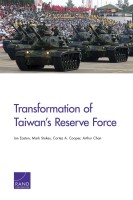| 来源类型 | Research Reports
|
| 规范类型 | 报告
|
| DOI | https://doi.org/10.7249/RR1757
|
| ISBN | 9780833097064
|
| 来源ID | RR-1757-OSD
|
| Transformation of Taiwan's Reserve Force |
| Ian Easton; Mark Stokes; Cortez A. Cooper III; Arthur Chan
|
| 发表日期 | 2017
|
| 出版年 | 2017
|
| 页码 | 110
|
| 语种 | 英语
|
| 结论 |
Assessing Taiwan's Reserve Force- Taiwan has demonstrated an outstanding ability to mobilize its military and society to respond to both man-made and natural disasters. However, the PLA is rapidly modernizing and developing capabilities that will challenge mobilization and employment of Taiwan's reserves in a cross-Taiwan Strait conflict.
- As the number of Taiwan's active-duty soldiers, sailors, airmen, and marines continue to decrease, and the active force transforms to a volunteer rather than a conscript force, reservists will need to assume increasingly difficult missions.
- Taiwan's current approach to reserve force training may be appropriate for many noncombat support personnel in the system, but it seems inadequate for maintaining the readiness of those reserve units that would see combat in the event of an all-out Chinese invasion.
Prospects for an Enhanced Strategic Role- As the political-military challenge from the People's Republic of China (PRC) grows in the years ahead, the reserve force may need to play a more prominent role in Taipei's approach to deterring PRC aggression.
- By linking reserve force reform and modernization efforts with leadership statements, military exercises, arms sales, and other politically sensitive aspects of Taiwan's defense, Taipei can confront authorities in Beijing with the reality that any invasion campaign they may consider undertaking would meet with overwhelming resistance.
|
| 摘要 |
- Employ the reserve force as an instrument of statecraft for deterring People's Republic of China (PRC) use of force and other forms of coercion — for example, by publicly highlighting the reserve force in leadership statements and military exercises, engaging in military-to-military exchanges with the United States, and having the reserves provide technically specialized personnel and units to augment the active force.
- Consider how the reserve force can undermine PRC advantages in the initial stages of an invasion scenario and better exploit domain-specific and geographic aspects of the conflict.
- Develop future reserve capabilities in three promising areas: constraining access to the electromagnetic domain by forming reserve units that specialize in electronic and cyber warfare; denying unimpeded access to the air domain by forming special reserve units for maintaining and operating large numbers of air defense missiles; and impeding access to the sea domain by forming special reserve units for operations employing anti-ship missiles, expanded mine warfare capabilities, advanced antisubmarine warfare technologies, and unmanned surveillance systems.
- Develop and resource new training programs to realize these future capabilities.
|
| 主题 | Finland
; Georgia (country)
; Japan
; Military Reserves
; Military Strategy
; Military Transformation
; Operational Readiness
; Singapore
; Taiwan
|
| URL | https://www.rand.org/pubs/research_reports/RR1757.html
|
| 来源智库 | RAND Corporation (United States)
|
| 引用统计 |
|
| 资源类型 | 智库出版物
|
| 条目标识符 | http://119.78.100.153/handle/2XGU8XDN/108632
|
推荐引用方式
GB/T 7714 |
Ian Easton,Mark Stokes,Cortez A. Cooper III,et al. Transformation of Taiwan's Reserve Force. 2017.
|
|
文件名:
|
x1518122468607.jpg
|
|
格式:
|
JPEG
|

|
文件名:
|
RAND_RR1757.pdf
|
|
格式:
|
Adobe PDF
|
除非特别说明,本系统中所有内容都受版权保护,并保留所有权利。